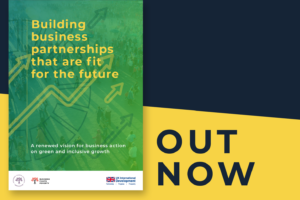In 2004, the European Space Agency (ESA) launched the robot probe Philae, with great ambition and hope, to learn about the origins of our Solar System. Human genius overcame the challenges of gravity, space and budget constraints in the name of scientific discovery. For 10 years, Philae travelled through space, to eventually reach its destination in perfect shape and make a historic first-ever landing on a comet. The robot started sending amazing pictures and performed valuable tests BUT its solar-powered battery limited its life. The robot happened to accidentally land in the shadow of a cliff. All the scientific brilliance, the investment and the astounding potential for new knowledge boiled down to a chance shade and battery recharge crisis.
As a development professional with 15 years of experience, I genuinely felt for the ESA scientists. The story of Philae is illustrative of my experience in aid: amazing dedication, sacrifice, hard work and innovation goes into poverty reduction but its success or failure often boils down to the simplest logistical constraints. Sadly, the constraints of outer space still exist across Africa and Asia.
I am currently the COO of the largest fund supporting the education of girls in developing countries, the Girls’ Education Challenge (GEC). The fund supports interventions in Afghanistan, Somalia, Kenya, Malawi and other 14 countries. We aim to help the most marginalised girls and, as such, our interventions are in the poorest, most remote areas. Where infrastructure is concerned, location and access makes all the difference between success and failure, poverty and wellbeing.
Our interventions face significant security and health risks; economic, cultural and political barriers. Brave and dedicated people work hard and at times risk their lives (and some have lost them) so that more girls can attend school and learn. Private sector and NGOs come together to work with governments, religious and tribal leaders to design and test solutions. From grants and loans to self-esteem programmes, from uniforms and books to ipads, we have had successes in the most unlikely of places. The challenges differ from place to place and as such the best solutions are contextual but they are all supported or crippled by the ‘battery’ of infrastructure.
The GEC supports a remarkable project led by Avanti Communications, the satellite data communications provider. In partnership with sQuid, Whizz Education and Camara, Avanti uses its satellite technology to provide broadband internet and access to a learning portal which includes mathematics and literacy modules – both teaching and testing students as they learn. The educational resources can be accessed on desktop computers in schools (and potentially, through laptops, tablets, phones and other devices) and resolve multiple problems efficiently: there is no need for book and paper shipments; information is always up to date; attendance and usage are monitored; student learning progress measured and corruption in exam marking can be prevented. In addition, students can study even if the teacher is overwhelmed by a large and varied class. Teachers in some of Kenya’s most rural schools are no longer isolated and can access email and Facebook as well as using the internet to access additional learning materials.
The GEC co-funded the project as a potential ground-breaking approach to education in countries with severely underfunded, understaffed and underachieving education systems. A number of potential risks were identified in the early stages of the project: theft, lack of commitment by communities, poverty, and Avanti has largely been successful at adapting its project to deal with these challenges. One of the most serious challenges to be overcome was the supply of electricity. Whilst all the schools were connected to the electrical grid, in many schools electricity is not available for the whole week, was not necessarily available in the classrooms where it was needed and sometimes the schools lack the finances to pay the bill. Satellite internet was installed, computers were delivered, but the critical enabler of electricity was unpredictable. And just like little Philae, our efforts to bring private sector into education, to overcome barriers and challenges, eventually ended up boiling down to a “battery recharge crisis.”
However, just like the engineers at ESA, the Avanti consortium has been adept at working around these problems. Classrooms have been wired and networked, electrical supplies have been extended to ICT labs and generators have been purchased to support teacher training.
This does beg the question why in this age of unprecedented technology when a manmade robot can recharge itself on a comet in outer space but children and households in a country like Kenya are still left in the dark. Do we approach these problems with sufficiently innovative minds? Some of us live in the ‘well-off’ part of the world that has become fixated on developing ‘smart’ cities. This usually means high-tech, urban innovation using data and technology-based solutions to improve city efficiency and service delivery. For example, smart metering for electricity and water is already being used to monitor energy demand in real time, enabling cost savings for consumers and better forecasting for power producers. Driverless cars are being tested.
In Africa and Asia, at the same time, billions of people are stranded in old and fragile infrastructure with overwhelmed services. Some African countries still have an electrification rate below 20% with no real prospect of centralised power production and distribution. The GEC funds 36 different interventions across 18 developing countries. In many of these ‘education’ interventions we have to start with very basic construction: buildings, painting, wash facilities, lamps and generators.
Generationally the girls we try to reach are digitally savvy (or have the potential to be), they are of the age of Philae or less. They are often stranded by the infrastructure in place but if this could be unlocked there is a huge untapped potential. Africa and Asia never developed widespread and functioning landlines. They ‘leapfrogged’ straight to mobiles and did so in a sustainable way. A similar story is evident with social media and e-mail in countries where print, papers and post never managed to develop the penetration that social media has. These examples are highly celebrated but exceptional. Where are the rest of the leapfrogging success stories? Driverless cars may not be a priority but computers and satellites may be. More, better or bigger roads are not the only solution to traffic jams. Improved connectivity helps by reducing the need to travel in the first place.
The donor agency or company to become the ‘NASA of development’ will make history. I have recently started to work again on infrastructure solutions for development as, after so many years, I have realised that they are the backbone of cost-effective, functional solutions. The more I study this issue, the more it occurs to me that we should not try to resolve the problems of Lagos or Kampala with London-like solutions. Most existing infrastructure solutions look remarkably similar. It may be worth thinking of Africa as we think of space, without constraints. Hopefully, advanced technology such as drones and self- recharging robots can be used in poverty reduction efforts and beyond space exploration and military missions.
Technological leapfrogging will not replace the need for basic infrastructure. But there is potential for it to contribute to inclusive, equitable and sustainable economic growth, rather than just creating ‘cool gadgets’. Policy makers need not wait for basic infrastructure to be in place, but can start smart by making best use of technology for planning and growth. This can help whole generations and nations to leapfrog physical infrastructure constraints and crippling infrastructure deficits.
ESA’s robot is a celebration of human genius and, despite its battery issues, it did manage to send valuable data. Similarly, the Avanti project’s use of satellites, mobiles and digital solutions for girls’ education is a celebration of the unlimited opportunities we have to resolve some of the most difficult problems. One day soon, I hope to see a significant development intervention in Africa undertaken in consultation with NASA or ESA rather than the traditional engineering firms and donors. We will not find alien life but we have a chance of improving the life of the most alienated.











One Response
Excellent blog. A growing number of young African women are studying science and engineering and they will play an increasingly important role in delivering the vital infrastructure that Africa needs.